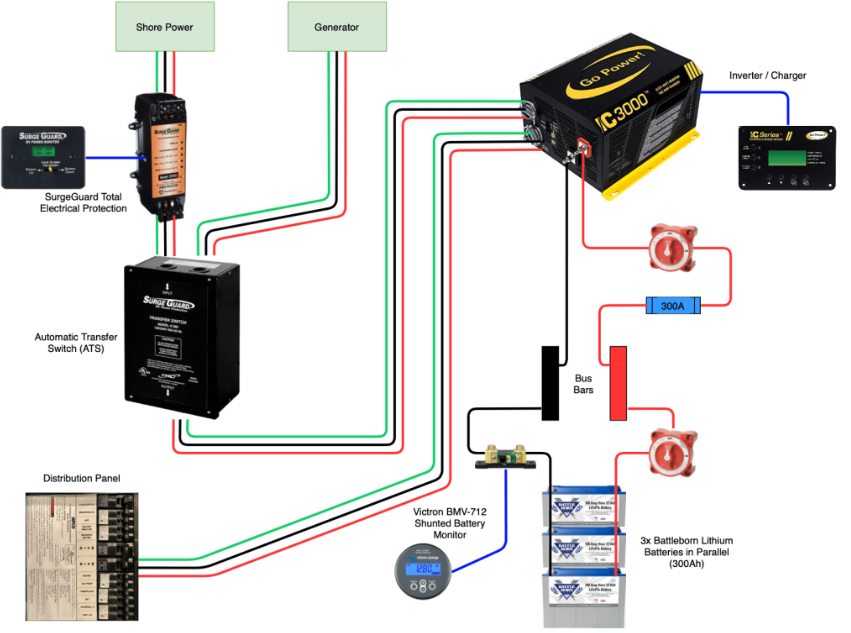As more people embrace the freedom of the open road through RV living or travel, understanding your vehicle’s electrical system becomes essential. One of the most critical components of this system is the RV inverter. But what exactly is it, and why is it so important?
An RV inverter is a device that converts DC (direct current) power from your RV batteries into AC (alternating current) power, which is what most household appliances and electronics use. If you want to power a coffee maker, laptop, microwave, or even charge your phone while off-grid, an inverter is a must.
How Does an RV Inverter Work?
To appreciate its value, you need to understand how an RV inverter functions. Most RV batteries store and deliver power in 12-volt DC. However, standard appliances, like those found in homes, run on 120-volt AC power.
An inverter steps in to convert 12V DC power into 120V AC power, allowing you to use your household devices even when you’re not connected to shore power or a generator. This conversion is seamless and safe when done with the right type and size of inverter.
Types of RV Inverters
There are three primary types of inverters used in RVs, each with specific features and benefits:
1. Modified Sine Wave Inverters
These are the most affordable option. They generate a power wave that is sufficient for many appliances, especially simple ones like lights or fans. However, they may cause issues or inefficiencies with sensitive electronics such as laptops, CPAP machines, or microwaves.
Best for: Budget-conscious RVers using basic electronics.
2. Pure Sine Wave Inverters
These produce a clean, smooth, and consistent AC power wave—similar to the electricity you get at home. They are ideal for delicate or high-performance electronics and tend to be more expensive than modified sine wave models.
Best for: Full-time RVers or anyone using sensitive devices.
3. Inverter/Charger Combos
These units combine an inverter with a battery charger and sometimes an automatic transfer switch. When connected to shore power, they recharge your batteries; when disconnected, they switch to inverting battery power for your appliances.
Best for: Users who frequently switch between shore power and off-grid use.
Choosing the Right Size Inverter for Your RV
Inverter sizing is critical to ensuring you have enough power for your needs. RV inverters are typically rated in watts, and you must match the inverter capacity to the total wattage of the devices you plan to run.
Steps to Determine the Right Size:
-
List all the appliances you want to run simultaneously.
-
Check the wattage (you can find this on the label or in the manual).
-
Add up the wattage to get your required load.
-
Add a safety margin of 20–30%.
For example, if you plan to run a 1000W microwave, a 200W laptop, and a 100W fan, you’ll need at least a 1500W inverter, though a 2000W inverter is safer and more future-proof.
Battery Considerations for RV Inverters
An inverter is only as good as the battery bank feeding it. The more appliances you want to run, the more power you’ll draw from your batteries. That’s why RVers often upgrade their battery systems when installing a large inverter.
Battery Types:
-
Lead-Acid (Flooded or AGM) – Traditional, affordable, but heavy and lower in lifespan.
-
Lithium (LiFePO4) – Lightweight, longer-lasting, more efficient, but more expensive.
Make sure your battery capacity (measured in amp-hours) can support the draw of the inverter over the duration you plan to use it.
Installation Tips and Safety
Installing an RV inverter can range from a simple DIY project to a complex setup requiring a professional.
Installation Tips:
-
Use short, thick cables to reduce voltage drop.
-
Install close to the battery bank to avoid energy loss.
-
Include a fuse or circuit breaker for safety.
-
Ensure adequate ventilation to prevent overheating.
If your inverter supports hardwiring or automatic transfer switching, you may want to consult an electrician or RV technician for a safe and compliant installation.
Top RV Inverter Brands to Consider
When shopping for an RV inverter, consider established and reliable brands. Some top-rated options include:
-
Victron Energy – Known for premium-quality inverters with smart features.
-
Xantrex – Offers a range of inverter/charger combos.
-
Renogy – Popular among DIY solar RV setups.
-
Go Power! – Ideal for full-time RVers looking for power solutions.
-
AIMS Power – Affordable and powerful inverters for larger setups.
Choose a brand that fits your budget, power needs, and installation preferences.
Using Your RV Inverter Effectively
Once installed, using your inverter efficiently will help preserve battery life and avoid overloading your system.
Tips for Effective Use:
-
Turn off the inverter when not in use.
-
Use energy-efficient appliances.
-
Monitor battery voltage regularly.
-
Install a battery monitor to keep track of consumption.
-
Avoid using high-wattage devices simultaneously.
Many RVers pair their inverter setup with solar panels, allowing them to recharge their batteries and stay off-grid for extended periods.
Benefits of Having an RV Inverter
Here are some of the biggest reasons RVers invest in a quality inverter:
-
Freedom to camp off-grid without sacrificing comfort.
-
No need to run a noisy generator for small appliances.
-
Increased flexibility and convenience for working, cooking, or entertainment.
-
More efficient power use when paired with lithium batteries and solar.
Whether you're a weekend warrior or a full-time nomad, having the right inverter system transforms your RV into a truly self-sufficient home on wheels.
Conclusion: Powering Your Adventure the Smart Way
The RV inverter is one of the most valuable tools for modern RVers who want independence from campgrounds and hookups. With the right size, type, and installation, your inverter can power everything from your coffee maker to your computer, all while enjoying the peace of remote camping.
Invest in a high-quality inverter, pair it with a capable battery system, and you’ll unlock the true potential of life on the road—freedom, comfort, and sustainability.




